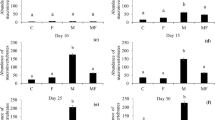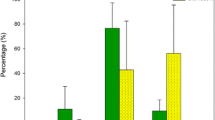Abstract
The riverine grass shrimp (Palaemonetes paludosus) and eastern mosquitofish (Gambusia holbrooki) consume periphyton and small invertebrates, potentially affecting periphyton through negative effects (i.e., consumption) and/or positive effects such as nutrient regeneration, physical stimulation, and trophic cascades. We performed field experiments in the Everglades in which omnivores and periphyton were maintained in cages, with a fraction of the periphyton held in omnivore-exclusion bags that allowed passage of nutrients but prevented its consumption or physical disturbance. In some instances, periphyton growth rate increased with increasing omnivore biomass. Omnivores probably stimulated periphyton growth through nutrient regeneration, possibly subsidizing periphyton with nutrients derived from ingested animal prey. The net balance of omnivore-mediated negative and positive effects varied among experiments because of seasonal and spatial differences in periphyton characteristics. Consumption of periphyton mats might have been reduced by the arrangement of palatable algae (green algae and diatoms) within a matrix of unpalatable ones (CaCO3-encrusting filamentous cyanobacteria). In a laboratory feeding experiment, mosquitofish consumed more green algae and diatoms in treatments with disrupted mat structure than in those with intact mats. No difference in diet was observed for shrimp. Our study underscores the complexity of consumer-periphyton interactions in which periphyton edibility affects herbivory and consumers influence periphyton through multiple routes that cannot be fully appreciated in experiments that only investigate net effects.



Similar content being viewed by others
References
Atsatt PR, O'Dowd DJ (1976) Plant defense guilds. Science 193:24–29
Beck JT, Cowell BC (1976) Life history and ecology of the freshwater caridean shrimp, Palaemonetes paludosus (Gibbes). Am Midl Nat 96:52–65
Bouchard SS, Bjorndal KA (2000) Sea turtles as biological transporters of nutrients and energy from marine to terrestrial ecosystems. Ecology 81:2305–2313
Brabrand A, Faafeng BA, Moritz Nilssen JP (1990) Relative importance of phosphorus supply to phytoplankton production: Fish excretion versus external loading. Can J Fish Aquat Sci 47:364–372
Carpenter SR, Cottingham KL, Schindler DE (1992) Biotic feedbacks in lake phosphorus cycles. Trends Ecol Evol 7:332–336
Cattaneo A, Mousseau B (1995) Empirical analysis of the removal rate of periphyton by grazers. Oecologia 103:249–254
Cuker BE (1983) Grazing and nutrient interactions in controlling the activity and composition of the epilithic algal community of an arctic lake. Limnol Oceanogr 28:133–141
DeAngelis DL (1992) Dynamics of nutrient cycling and food webs, 1st edn. Chapman & Hall, New York
Deegan LA (1993) Nutrient and energy transport between estuaries and coastal marine ecosystems by fish migration. Can J Fish Aquat Sci 50:74–49
Diehl S (1993) Relative consumer sizes and the strengths of direct and indirect interactions in omnivorous feeding relationships. Oikos 68:151–157
Drenner RW, Smith JD, Threlkeld ST (1996) Lake trophic state and the limnological effect of omnivorous fish. Hydrobiologia 319:213–223
Eaton AD, Clesceri LS, Greenberg AE (1995) Standard methods for the examination of water and wastewater, 19th edn. American Public Health Association, Washington, DC
Elser JJ, Goldman CR (1990) Experimental separation of the direct and indirect effects of herbivorous zooplankton on phytoplankton in a subalpine lake. Verh Int Verein Limnol 24:493–498
Feminella JW, Hawkins CP (1995) Interactions between stream herbivores and periphyton: a quantitative analysis of past experiments. J North Am Benthol Soc 14:465–509
Geddes P (1999) Omnivory and periphyton mats: uncoupling and quantifying consumer effects in the Florida Everglades. Master's Thesis. Florida International University, Miami, Fla.
Gresens SE (1995) Grazer diversity, competition and the response of the periphyton community. Oikos 73:336–346
Hay ME, Kappel QE, Fenical W (1994) Synergisms in plant defenses against herbivores: interactions of chemistry, calcification, and plant quality. Ecology 75:1714–1726
Hillebrand H, Kahlert M (2001) Effect of grazing and nutrient supply on periphyton biomass and nutrient stoichiometry in habitats of different productivity. Limnol Oceanogr 46:1881–1898
Hudson JJ, Taylor WD, Schindler DW (1999) Planktonic nutrient regeneration and cycling efficiency in temperate lakes. Nature 400:659–661
Hunt BP (1952) Food relationships between Florida spotted gar and other organisms in the Tamiami Canal, Dade County, Florida. Trans Am Fish Soc 82:13–33
Huntly N (1991) Herbivores and the dynamics of communities and ecosystems. Annu Rev Ecol Syst 22:477–503
Jones JI, Moss B, Young JO (1998) Interactions between periphyton, nonmolluscan invertebrates, and fish in standing freshwaters. In: Jeppesen E, Sondergaard M, Sondergaard M, Christoffersen K (eds) The structuring role of submerged macrophytes in lakes, 1st edn. Springer, Berlin Heidelberg New York, pp 69–90
Kitchell JF, O'Neill RV, Webb D, Gallepp GW, Bartell SM, Koonce JF, Ausmus BS (1979) Consumer regulation on nutrient cycling. BioScience 29:28–34
Krause PR, Bray RN (1994) Transport of cadmium and zinc to rocky reef communities in feces of the blacksmith (Chromis punctipinnis), a planktivorous fish. Mar Env Res 38:33–42
Kupferberg S (1997) Facilitation of periphyton production by tadpole grazing: functional differences between species. Freshw Biol 37:427–439
Kushlan JA, Voorhees SA, Loftus WF, Frohring PC (1986) Length, mass, and calorific relationships of Everglades animals. Fla Sci 49:65–79
Lamarra VA (1975) Digestive activities of carp as a major contributor to the nutrient loading of lakes. Verh Int Verein Limnol 19:2461–2468
Lamberti GA (1996) The role of periphyton in benthic food webs. In: Stevenson RJ, Bothwell ML, Lowe RL (eds) Algal ecology, 1st edn. Academic Press, San Diego, pp 533–564
Leibold MA (1989) Resource edibility and the effects of predators and productivity on the outcome of trophic interactions. Am Nat 134:922–949
Loftus WF (2000) Accumulation and fate of mercury in an everglades aquatic food web. PhD dissertation, Florida International University, Miami, Fla.
Loftus WF, Eklund A (1994) Long-term dynamics of an Everglades small-fish assemblage. In: Davis SM, Ogden JC (eds) Everglades: the ecosystem and its restoration, 1st edn. St. Lucie Press, Delray Beach, pp 461–484
Loreau M (1995) Consumers as maximizers of matter and energy flow in ecosystems. Am Nat 145:22–42
Matveev V, Matveeva L, Jones GJ (1994) Phytoplankton stimulation by mosquitofish in the presence of large Daphnia. Verh Int Verein Limnol 25:2193–2197
de Mazancourt C, Loreau M, Abbadie L (1998) Grazing optimization and nutrient cycling: when do herbivores enhance plant production? Ecology 79:2242–2252
McCormick PV (1994) Evaluating the multiple mechanisms underlying herbivore-algal interactions in streams. Hydrobiologia 291:47–59
McCormick PV, O'Dell MB (1996) Quantifying periphyton responses to phosphorus in the Florida Everglades: a synoptic-experimental approach. J North Am Benthol Soc 15:450-468
McCormick PV, Stevenson RJ (1991) Grazer control of nutrient availability in the periphyton. Oecologia 86:287–291
McCormick PV, Rawlik PS, Lurding K, Smith EP, Sklar FH (1996) Periphyton-water relationships along a nutrient gradient in the northern Florida Everglades. J North Am Benthol Soc 15:433–449
McNaughton SJ (1978) Serengeti ungulates: feeding selectivity influences the effectiveness of plant defense guilds. Science 199:806–807
Merz MUE (1992) The biology of carbonate precipitation by cyanobacteria. Facies 26:81–102
Meyer JL, Schultz ET, Helfman GS (1983) Fish schools: an asset to corals. Science 220:1047-1049
Newman JA, Bergelson J, Grafen A (1997) Blocking factors and hypothesis testing in ecology: is your statistics text wrong? Ecology 78:1312–1320
Pennings SC, Paul VJ (1992) Effect of plant toughness, calcification, and chemistry on herbivory by Dolabella auricularia. Ecology 73:1606–1619
Pfister CA, Hay ME (1988) Associational plant refuges: convergent patterns in marine and terrestrial communities result from differing mechanisms. Oecologia 77:118–129
Polis GA, Strong DR (1996) Food web complexity and community dynamics. Am Nat 147:813–846
Porter KG (1976) Enhancement of algal growth and productivity by grazing zooplankton. Science 192:1332–1334
Porter KG (1977) The plant-animal interface in freshwater ecosystems. Am Sci 65:159–170
Power ME (1990) Resource enhancement by indirect effects of grazers: Armored catfish, algae, and sediment. Ecology 71:897–904
Pringle CM, Blake GA, Covich AP, Buzby KM, Finley A (1993) Effects of omnivorous shrimp in a montane tropical stream: sediment removal, disturbance of sessile invertebrates and enhancement of understory algal biomass. Oecologia 93:1–11
Schaus MH, Vanni MJ (2000) Effects of gizzard shad on phytoplankton and nutrient dynamics: role of sediment feeding and fish size. Ecology 81:1701–1719
Schindler DE, Scheuerell MD (2002) Habitat coupling in lake ecosystems. Oikos 98:177–189
Schindler DE, Carpenter SR, Cottingham KL, He X, Hodgson JR, Kitchell JF, Soranno PA (1996) Food web structure and littoral zone coupling to pelagic trophic cascades. In: Polis GA, Winemiller KO (eds) Food webs: integration of patterns and dynamics, 1st edn. Chapman & Hall, New York, pp 96–105
Steinman AD (1996) Effects of grazers on freshwater benthic algae. In: Stevenson RJ, Bothwell ML, Lowe RL (eds) Algal ecology, 1st edn. Academic Press, San Diego, pp 341–373
Sterner RW (1986) Herbivores' direct and indirect effects on algal populations. Science 231:605–607
Taylor RC, Trexler JC, Loftus WF (2001) Separating the effects of intra- and interspecific age-structured interactions in an experimental fish assemblage. Oecologia 127:143–152
Trexler JC, Loftus WF, Jordan CF, Chick J, Kandl KL, McElroy TC, Bass OL (2001) Ecological scale and its implications for freshwater fishes in the Florida Everglades. In: Porter JW, Porter KG (eds) The Everglades, Florida Bay, and coral reefs of the Florida Keys: an ecosystem sourcebook, 1st edn. CRC, Boca Raton, pp 153–181
Turner AM, Trexler JC, Jordan CF, Slack SJ, Geddes P, Chick JH, Loftus WF (1999) Targeting ecosystem features for conservation: Standing crops in the Florida Everglades. Conserv Biol 13:898–911
Van Meter-Kasanof N (1973) Ecology of the microalgae of the Florida Everglades. Part I. Environment and some aspects of freshwater periphyton. Nova Hedwigia 24:619–664
Vanni MJ (1996) Nutrient transport and recycling by consumers in lake food webs: implications for algal communities. In: Polis GA, Winemiller KO (eds) Food webs: integration of patterns and dynamics, 1st edn. Chapman & Hall, New York, pp 81–95
Vanni MJ, Findlay DL (1990) Trophic cascades and phytoplankton community structure. Ecology 71:921–937
Vanni MJ, Layne CD (1997) Nutrient recycling and herbivory as mechanisms in the "top-down" effect of fish on algae in lakes. Ecology 78:21–40
Wahl M, Hay ME (1995) Associational resistance and shared doom: effects of epibiosis on herbivory. Oecologia 102:329–340
Acknowledgements
We thank Ron Jones and the Southeastern Environmental Research Center (SERC) for processing nutrient samples, and Sue Perry for assistance and support. Thanks to the 23 people who helped with fieldwork, making this project possible. We thank J.H. Chick who provided help with several conceptual areas of this project. We also greatly appreciate the comments of C. Osenberg, which improved this manuscript considerably. This work was funded by cooperative agreement number CA5280-8-9002 between Everglades National Park and Florida International University, and a fellowship to P. Geddes from the FIU Tropical Biology Program. This is SERC contribution 199 and 61 of the FIU Tropical Biology Program.
Author information
Authors and Affiliations
Corresponding author
Rights and permissions
About this article
Cite this article
Geddes, P., Trexler, J.C. Uncoupling of omnivore-mediated positive and negative effects on periphyton mats. Oecologia 136, 585–595 (2003). https://doi.org/10.1007/s00442-003-1294-4
Received:
Accepted:
Published:
Issue Date:
DOI: https://doi.org/10.1007/s00442-003-1294-4




